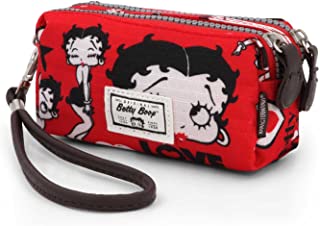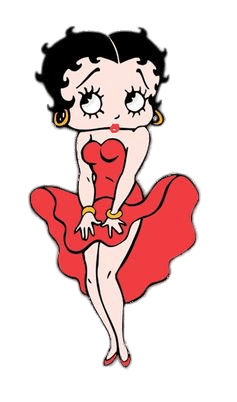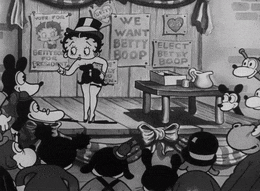
Unofficial Betty Boop cartoon wiki page
'Betty Boop' toys, costumes, goodies & gadgets
You can discover a selection of ‘Betty Boop’ merchandise on Amazon
All you need to know about
Betty Boop
Disclaimer: we are a participant in the Amazon Services Associates Program, an affiliate advertising program designed to provide a means for us to earn fees by linking to Amazon.com and affiliated sites.
Country of origin
United States of America
Creation year
1930
Creator(s)
Max Fleischer, with Grim Natwick et al.
Story
“Betty Boop” is an American animated series that first aired in 1930. Created by animator Max Fleischer, the series featured a charming and flirtatious female character named Betty Boop, who quickly became one of the most popular and recognizable cartoon characters of the 1930s.
The animation style of “Betty Boop” was distinctive and memorable, featuring bold lines, exaggerated movements, and a unique sense of humor. The series was known for its creative use of music and sound effects, as well as its imaginative and surreal storylines.
The stories in “Betty Boop” were often simple and formulaic, but they were always entertaining and engaging. Betty would typically find herself in some kind of predicament, such as being chased by a group of villains or trying to win the heart of her boyfriend, Bimbo. However, she always managed to triumph in the end, thanks to her wit and charm.
One of the most iconic aspects of the series was Betty’s distinctive appearance. She had large, exaggerated eyes, a curvy figure, and a playful demeanor that made her instantly recognizable. Her character was also known for her trademark “boop-oop-a-doop” catchphrase, which became a cultural sensation and helped to cement her status as a pop culture icon.
The series also introduced a number of recurring characters, such as Betty’s dog Pudgy, her friends Koko the Clown and Grampy, and her frequent nemesis, the villainous Professor. These characters added depth and variety to the stories, and helped to build a consistent world for the series.
Despite its popularity, “Betty Boop” was eventually cancelled in 1939, due in part to concerns over the sexualized nature of the character and her animated world. However, the character and her trademark catchphrase have since become a beloved part of American pop culture, and Betty remains a beloved icon of animation to this day.
“Betty Boop” was an important and influential series in the history of American animation, and helped to establish Max Fleischer as one of the most innovative and successful animators of his time. Its legacy continues to be felt in the animation industry today, and it remains a beloved classic among fans of early animation.
The animation style of “Betty Boop” was distinctive and memorable, featuring bold lines, exaggerated movements, and a unique sense of humor. The series was known for its creative use of music and sound effects, as well as its imaginative and surreal storylines.
The stories in “Betty Boop” were often simple and formulaic, but they were always entertaining and engaging. Betty would typically find herself in some kind of predicament, such as being chased by a group of villains or trying to win the heart of her boyfriend, Bimbo. However, she always managed to triumph in the end, thanks to her wit and charm.
One of the most iconic aspects of the series was Betty’s distinctive appearance. She had large, exaggerated eyes, a curvy figure, and a playful demeanor that made her instantly recognizable. Her character was also known for her trademark “boop-oop-a-doop” catchphrase, which became a cultural sensation and helped to cement her status as a pop culture icon.
The series also introduced a number of recurring characters, such as Betty’s dog Pudgy, her friends Koko the Clown and Grampy, and her frequent nemesis, the villainous Professor. These characters added depth and variety to the stories, and helped to build a consistent world for the series.
Despite its popularity, “Betty Boop” was eventually cancelled in 1939, due in part to concerns over the sexualized nature of the character and her animated world. However, the character and her trademark catchphrase have since become a beloved part of American pop culture, and Betty remains a beloved icon of animation to this day.
“Betty Boop” was an important and influential series in the history of American animation, and helped to establish Max Fleischer as one of the most innovative and successful animators of his time. Its legacy continues to be felt in the animation industry today, and it remains a beloved classic among fans of early animation.
Who are the main characters of Betty Boop?
Betty Boop: A sassy and sexy cartoon character who often finds herself in precarious situations.
Bimbo: Betty's canine companion who is often by her side.
Grampy: Betty's wise and wizened grandfather who is always ready to offer sage advice.
KoKo the Clown: A clown who is often featured in Betty's cartoons. He is clumsy and funny.
Koko the Baby: Ko-Ko's son who is also often featured in Betty's cartoons. He is mischievous and curious.
King of Cartoons: The king who presides over the world of cartoons. He is often befuddled by the goings-on in Betty's cartoons.
Queen of Cartoons: The queen who presides over the world of cartoons. She is often bemused by the goings-on in Betty's cartoons.
Betty's Mom: Betty's loving and supportive mother.
Betty's Dad: Betty's hardworking and loving father.
Pudgy: Betty's pet cat who is often featured in her cartoons. He is lazy and loves to eat.
Production studio: Fleischer Studios
The information provided on this page about Betty Boop isn’t endorsed by the creators or the production. It has been compiled by fans of the character(s) who want to share their passion. Feel free to share it if you also love this cartoon!
Betty Boop PNG images
Discover Betty Boop characters in PNG format



















